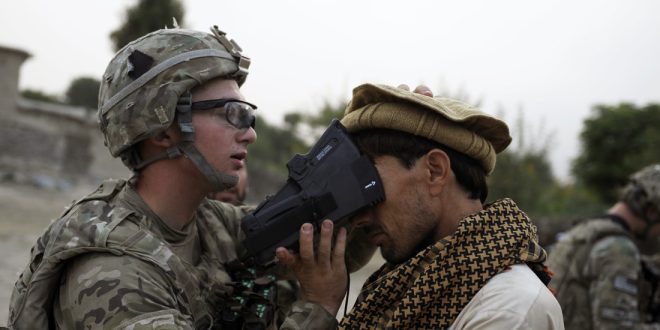AT News
KABUL – With the withdrawal of US troops from Afghanistan in 2021, a pressing concern has emerged regarding the security of sensitive data left behind. The Taliban swiftly gained access to a vast collection of data, including biometric information such as iris scans and fingerprints, along with photographs, addresses, and the names of relatives. This development has potentially placed thousands of Afghans at risk across the country, as some of them may have assisted or worked with US embassies under promises of resettlement opportunities in the USA, reveals a report by the NGO Human Rights Watch, authored by Quito Tsui.
The issue of collecting biometric data from vulnerable individuals extends beyond Afghanistan, as highlighted in the report by Tsui and her colleagues at the Engine Room, a non-profit organization specializing in technology and data. The report sheds light on various high-profile incidents illustrating the growing use and associated risks of biometrics in the humanitarian sector.
According to the United Nations, the number of people in need of humanitarian assistance has surged by 30% since the beginning of 2022, reaching an estimated 360 million worldwide. As humanitarian organizations grapple with meeting these increased needs, biometrics have become an essential tool since the early 2000s, simplifying aid registration and distribution processes, especially for those lacking traditional identification documents like passports.
The adoption of digital biometric systems for collecting iris, hand, or fingerprint scans has become standard practice in humanitarian work. Some organizations have embraced this technology, partly due to donor demands for detailed expenditure reports. By the close of 2020, nearly 63.8 million biometric profiles were registered in the World Food Programme’s SCOPE database.
However, Tsui points out that while aid organizations tout the benefits of biometric data systems, such as enhanced efficiency and fraud prevention, there is insufficient evidence or research to substantiate these claims. Most critically, many organizations have failed to reevaluate their use of biometric data in light of mounting evidence of potential harm.
The new report highlights key concerns, including function creep, data security, and data misuse. Tsui emphasizes that the risks faced by individuals relying on humanitarian aid when their data is collected are similar to those faced by anyone else but are much more likely to occur. For instance, in 2018, Rohingya refugees in a Bangladesh camp protested against the issuance of smart ID cards after the Bangladeshi government shared their biometric data with the Myanmar junta, which has a history of persecuting the Rohingya people.
Among the challenges associated with biometric data collection, the lack of consent is particularly problematic. Tsui explains that people fleeing danger often arrive in large groups, often hurriedly or even in the middle of the night, making informed consent nearly impossible. In reality, individuals seeking aid often have no alternative but to comply. Tsui notes that aid organizations have been evasive when questioned about the consequences of refusing consent, and in many cases, there is no viable alternative in place.
While it may appear that reversing the reliance on biometrics is difficult, Belkis Wille, associate director of the Crisis and Conflict division at Human Rights Watch, points to the humanitarian response to the Ukraine crisis as a potential alternative. Many Ukrainians and local humanitarian groups supporting them resisted sharing their biometric data with international agencies, leading these agencies to drop the requirement. Ukraine’s stance on biometric data collection has undoubtedly made a compelling case for reevaluating its use in humanitarian operations, a sentiment echoed by Tsui.
In the face of growing concerns and challenges surrounding biometric data collection in the humanitarian sector, a critical examination of its practices and potential alternatives is imperative to safeguard the security and privacy of vulnerable individuals in need of assistance.
 Afghanistan Times
Afghanistan Times




